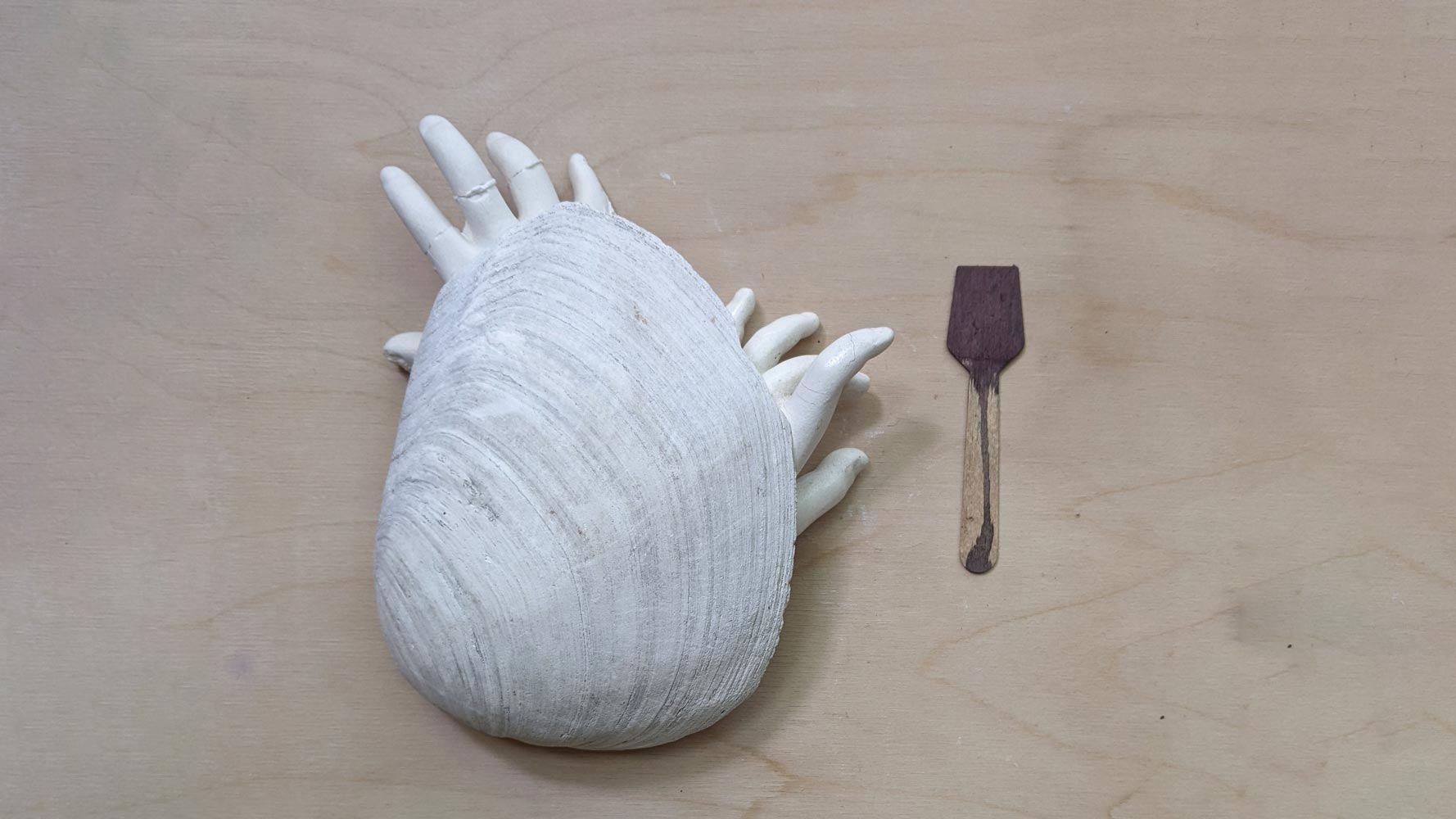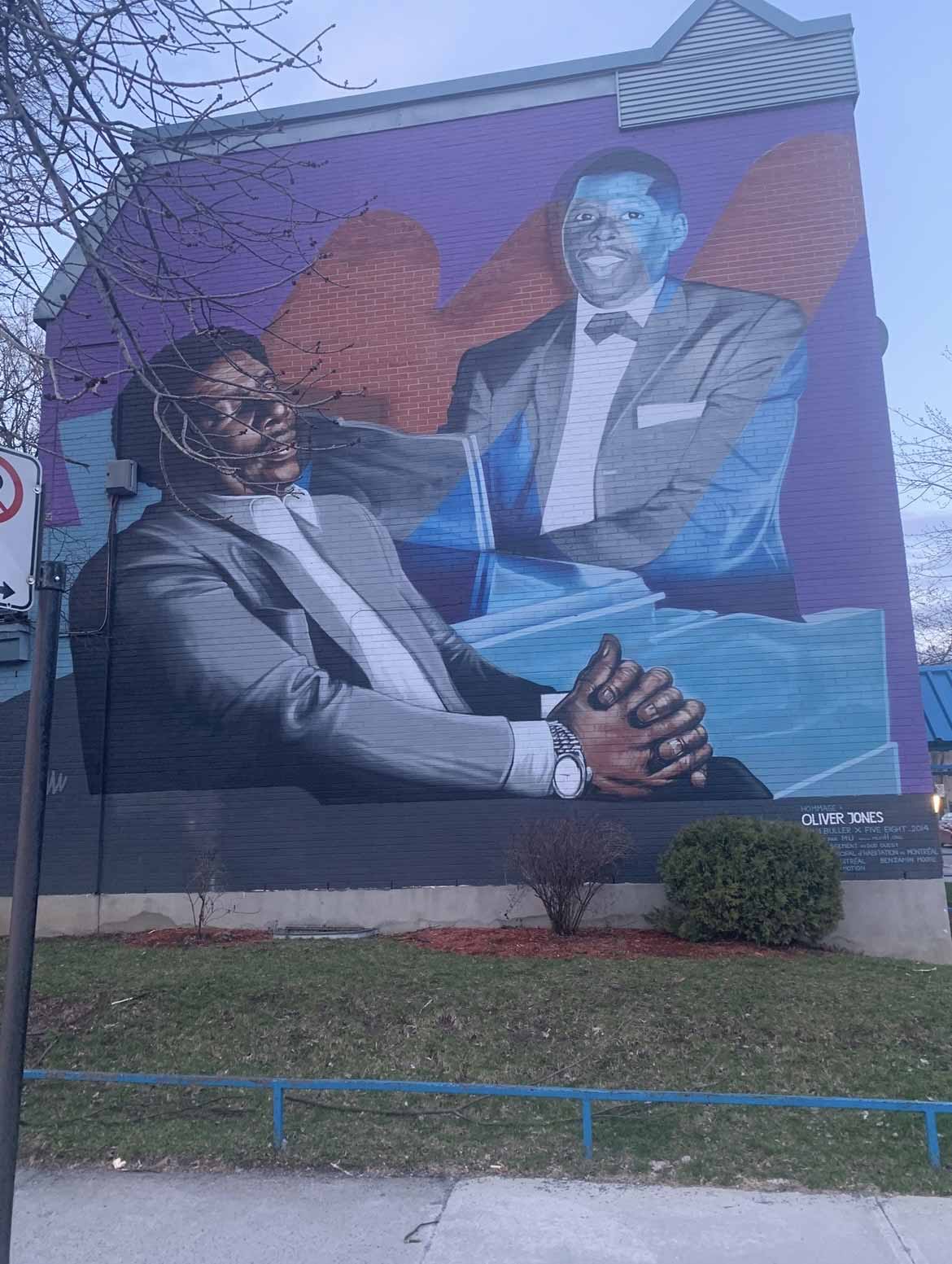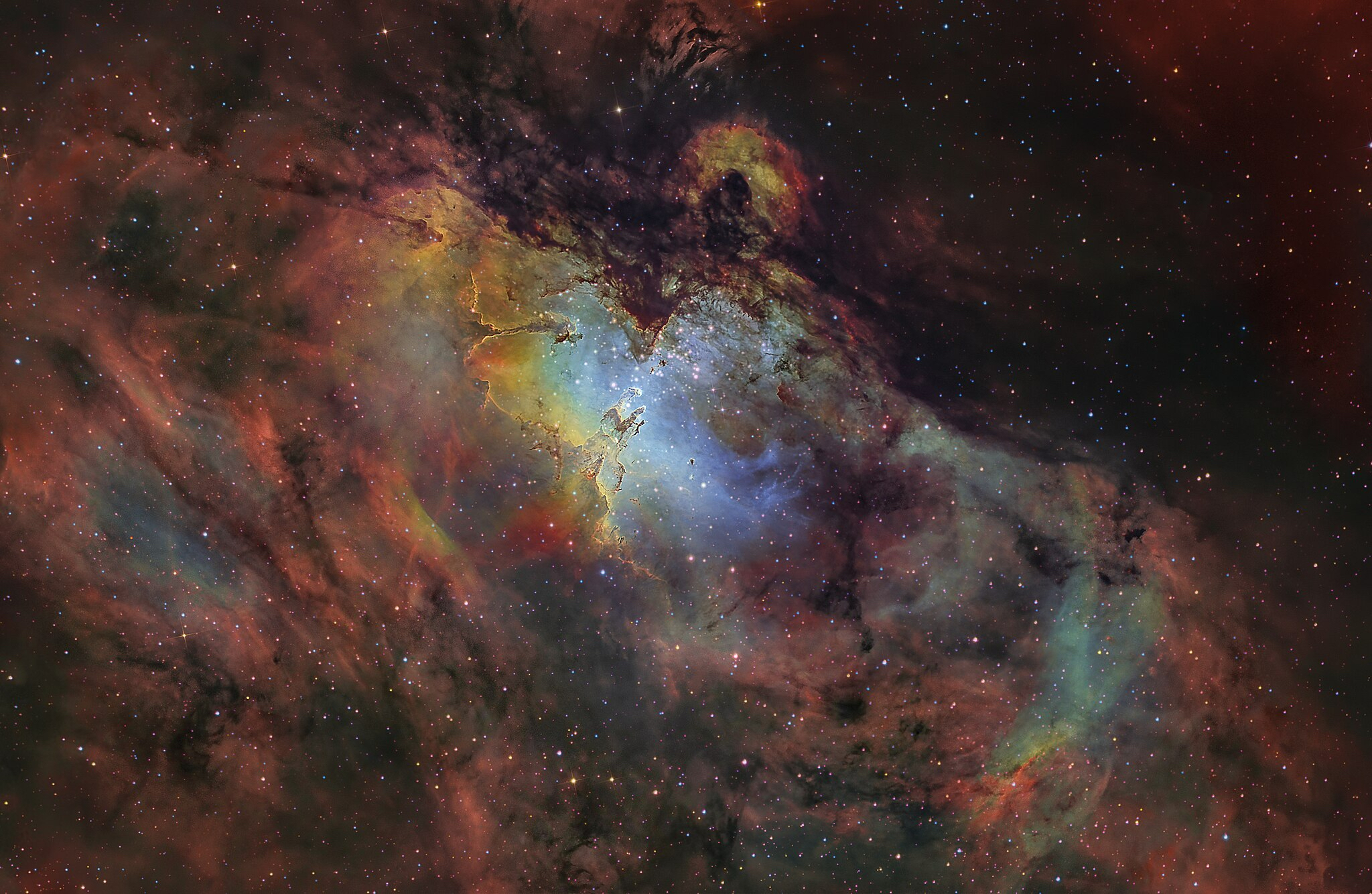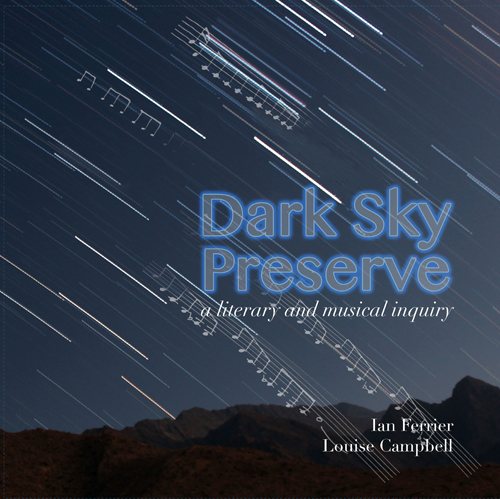
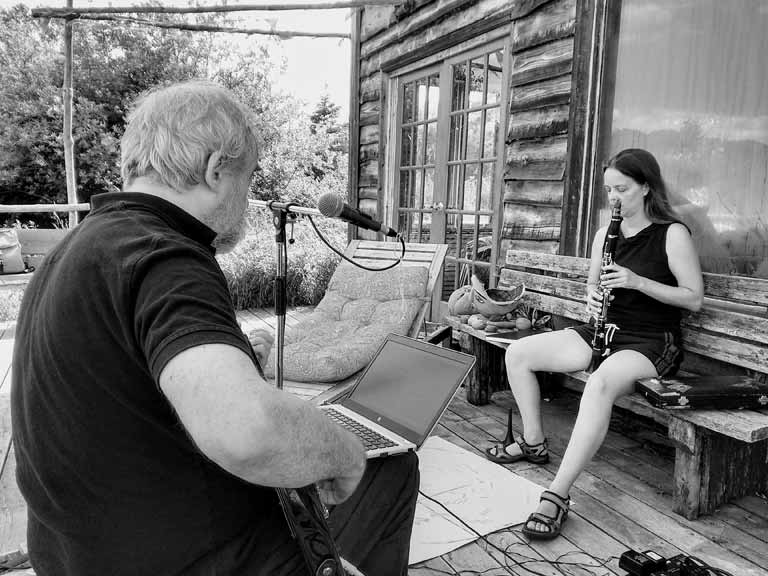
Dark Sky Preserve is a literary and musical inquiry into ways in which we connect and disconnect from ourselves and others in our search for our place in the universe. In this meditation on the night sky, spoken word artist Ian Ferrier, musician Louise Campbell and visual artist Sarah Beth Goncarova collaborated to produce a score book and album designed for others to read, listen to, reflect on, enjoy and gain inspiration from to create their own music based on these works.
Interview with Ian and Sarah Beth
Q: How did your interest in the stars and the night sky start?
Ian: I was working with Louise Campbell studying what was our next step for the music and voice and all we did together. Sitting each night at Mont-Mégantic, we discovered we’re in the middle of this huge, dark sky and there’s constellations, there’s everything. We saw that over many nights and we would catch that sky – just catch how to be underneath the dark sky. That dark sky became what we could find out about the universe. How is it that we can look into the universe and figure out how to be a person who wants to engage with the sky and the stars and our position in space?
Q: Reading your words in Dark Sky Preserve, I remembered how as a kid, during summers in the Laurentians, we’d lie on our backs and just look at the stars.
Ian: I used to do that with my son Michael, looking for constellations, but in Mont-Mégantic there was a massive number of stars, they were everywhere. We had that same experience later on in Lion’s Head in Ontario. We talked to people about the stars, and one lady working there showed us how to find each constellation from Aquarius to Libra to Pisces to Sagittarius. That’s when I started to write and when we started to work together on how the stars appeared to us.
Q: Dark Sky Preserve is based on improvisational collaboration between you and Louise. How do you improvise with the words and music?
Ian: We improvised with all the pieces directly. I played voice and guitar and Louise played clarinet. In “Rail Music” I was using a synthesizer to get a lot of the sound of the train. That happened a number of times.
Q: Did you improvise on the words as well?
Sarah Beth: There is one section in “Incantation” where he improvises the names of the people, depending on who’s there in the room with him.
Ian: I did improvise on those names. “When I Arrive at Still Waters” was spoken word and clarinet, no guitar. It was how we started and how Louise improvised on the clarinet. It was those two things.
Sarah Beth: I remember when Ian wrote “When I Arrive at Still Waters.” He wrote it within two days. It just came out perfectly formed. I remember that day.
Q: What do you like about playing with Louise?
Ian: We’ve always done good stuff and we say, “What are we gonna do?” We’re going, “Oh, we don’t know what we’re gonna do.” We would start up and then we did something every single time.
Q: Have you played with other people? Has it been different than with Louise?
Ian: I have played with other people. I haven’t played as constantly as I have with Louise. I’ve done music for people and music in my own work, but Louise was the best.
Sarah Beth: This is a true creative collaboration between the two of them that I don’t think he shares with people he’s worked with on other albums. They have played together for 15 years, very intimate.
Q: What was the difference between playing music and doing your poems by yourself and collaborating with Louise?
Ian: I’ve done stuff by myself but there hasn’t been anything as complete and continuous as my work with Louise. It gives a new dimension and other life to the work. We’d sit down and we’d say, “We don’t know what to do and what’s happening and how to figure things out.” We’d put some music down, and all of a sudden we’d know what to do and what’s happening and how to figure things out. That’s 15 years, and it was always so simple and smart. I’d go “Oh, wow, look, you’re going way down there and I want to listen to that.” I’d just start playing, answering to what she did. Then she’d start answering to what I did. We had that all the time.
Q: What is your favorite piece on the album? What do you like about it?
Ian: I like “Rail Music.” It’s the most interesting, the most thoughtful, you can hear it from a long way off, “Whoooooo.” I started working on a piece years ago called “Blue Train.” I thought it was a freight car but it turned out there was no freight. I was in the Canadian Badlands in those wild Alberta hills around Drumheller where dinosaurs lived some 70 million years ago. Initially with that thought of music and voice and talk and a train, it became important in my own life to remember that that happened at the time and to see it in pieces like “Rail Music” where it becomes really simple. You can hear it from a long way off, and you can hear the train.
Q: Your poem O My Sisters is complex but I couldn’t figure out who the sisters were. Are they specific people in your life, or metaphors or iconic characters?
Ian: They are specific people, people like Sarah Beth Goncarova or Louise Campbell. It came from people I’ve known and loved.
Q: How did you choose the photos in the book?
Sarah Beth: For some of the photos we wanted to use, we had to ask permission from Richard Fleet, an astronomer in the UK. I looked at his photographs and I picked the most stunning. He was happy to have his photography included. In Mont-Mégantic, I stayed for two or three months and took a lot of photos and picked the best ones from that trip and from living there.
Q: (To Sarah Beth) You took the picture of him and of the two of them on the balcony.
Sarah Beth: Standing up on a stool. I knew there was something special happening at that moment and I wanted to document it.
Q: What are your hopes for the book and the album now that they have been launched?
Ian: I know Louise has plans to get it in the hands of music teachers and professors and into Dark Sky Preserves. We’ve heard from people who have been interested in our book. I would love to get it into libraries across Canada. We’re running toward the end of the print run. We had maybe 180 copies or 200 copies so it’s not huge. Our desire is to present it to anyone who might be interested.
Q: Are you pleased with the collaboration and the resulting music and words?
Ian: I’m thrilled. Sarah Beth did “When I Arrive at Still Waters” at our live show back on February 19, 2023. People were going, “Oh my god, this is beautiful.”
Sarah Beth: I finished putting the book together in November, early December of 2019. Then COVID hit. We knew there was no chance that we’d be able to market it until things calmed down, and we had no idea how long that was going to be. Then Ian’s glioblastoma hit and now we’re dealing with that, and so marketing a book and album… there’s only so much you can do in a day.
Q: Is there anything you want to add?
Ian: The universe is a long-lasting thing. While doing this project, when we were up by Lion’s Head, we were talking with a gentleman and his partner who were deep astronomers and collaborators about how everything works and how to manage all the stars. I wanted to hear more, each time something came out of it. I wish I knew more about the universe.
This universe is a huge thing. Do we have all we know about the universe? No, we don’t know it all yet. How are we going to figure out what the hell’s going on for us? And there’s one of the good answers: the universe.
Q: We are each a universe.
Ian: I like that.
Interview with Louise
Q: How did you arrive at the title for your book?
Louise: Dark Sky Preserves are protected areas to give us greater visibility and access to the night sky, with the scientific goal of preserving darkness to protect the migration patterns and circadian rhythms of animals, birds and humans. There are over 24 Dark Sky Preserves across Canada where you can enjoy the night sky. The music we created was about stars and preservation.
Q: Are there Dark Sky Preserves in other parts of the world?
Louise: They’re around the world, and many have national park status in Canada. The closest one to Montréal is in Mont-Mégantic.
Q: When did you start improvising with your music and your clarinet?
Louise: I have improvised since I was a kid. My earliest and strongest memories are improvising on the piano with a thunderstorm. I am a classical musician. I went through conservatory-style training and at a certain point, in my early 20s, I started improvising with dancers according to their movement. Then I did a Master’s with a minor in jazz improvisation. Later, I played with guitar gear and loopers, and with that you have to improvise. The loop that you make is never the same length and everything comes out slightly different. A looper is a basic guitar pedal where you record a track that is a certain length of time, like say 10 seconds or 30 seconds. It records that and plays it over and over. As a clarinet player, that gives me the possibility to play multiple lines at once, not just one melodic line. I can create harmonies and use various effects. I improvised with a looper playing with Ian.
Q: In the musical pieces, how did you start the improvisation with Ian?
Louise: We start with playing. Ian creates the atmosphere, picks the key and the mode and I play with that. We do call and response to build up material. I tend to improvise with a bit of a structure. One piece might be based on motivic development, another using minimalist processes. If Ian decides he’s doing spoken word, then I’ll respond to the imagery in the poem, and it evolves from there. It starts out as true improvisation of an exchange between two people. As you move along, the pieces become more structured and these structures are what you’ll find in the Dark Sky Preserve score book.
Q: In the book, there are scores for the pieces for guitar, words, synth and clarinet. How would you advise someone who’s not well versed in written music to follow the scores?
Louise: The scores are for inspiration. They are used in conjunction with the audio. Listen to the audio and the words and look at the images. The scores aren’t just musical notes on the page. One of the scores, “Dark Skies,” is a few melodic motives, but mostly the image of a time lapse of the night sky, where you see the blurred lines of the stars as they go through the night sky. For somebody who doesn’t read music, they can draw more inspiration from the image of that slow rotation of the night sky.
Q: If somebody just played the musical notation, what would happen?
Louise: The musical notation is a starting point. Somebody who reads musical notation can look at a small motive on that page and pick up something about the rhythm and use that rhythm throughout their interpretation of that piece. Somebody else might pick up on the pitches that are written, or the mode, or the motive that’s shown on that page. It’s a starting-off point, in the way that a jazz chart is, for improvisation.
Q: How do you choose the way the music develops?
Louise: I like development and structure. A lot happens based on Ian’s spoken word. “Rail Music” is the piece we played for the longest in the album, over 15 years. It’s about being on a train and what it’s like to take a train. The sound of a train is a perpetual motion. You get this constant sound, but there’s evolution because you’re on a journey. That constant sound changes if you’re speeding up to full speed ahead or slowing down. I interpreted that as having a perpetual motion 16th-note figure on the clarinet that started very low, and then slowly evolving it to make that 16th-note figure go higher and higher until it becomes a long melodic line.
Q: You have been playing the “Rail Music” piece for 15 years. How did you choose the version in the book?
Louise: “Rail Music” evolved over those 15 years that we played it. It’s like making sketches before you record the final thing. If you’re doing visual arts, you might sketch a bunch of things before putting it together for the final painting.
Q: Why did you choose to handwrite the scores in the book?
Louise: There’s an intimacy about things that are handmade. People receive it like it’s a gift, and treasure it more than if it’s something that’s done on a computer. Our music lends itself to spatial representation on a page, which is hard to do in computer programs and much easier to do handwritten. Besides it being difficult to make the notation software do what I want, there’s more flexibility and aesthetic pleasure to doing it by hand.

Q: What is your favourite piece and what do you like about it?
Louise: The instrumental one, “Dark Skies,” is particular because we’re working with a different mode and there’s no text, which is different than everything else that has spoken word. It’s this little tiny miniature that was captured in time and space. And “Rail Music.” I like that one because it has a sense of progression not found in other pieces. “When I Arrive at Still Waters” is one of my favourites, because the storytelling in the poetry is so evocative. That one we chose to have just on clarinet, rather than clarinet and guitar. That sets it apart because of the fairly different sound without the guitar in there.
Q: The section on the Perseids meteor showers is not only an improvisation with words and music, it is also a visual “star chart.” Can you explain how you arrived at creating that?
Louise: That was done in collaboration with Sarah Beth. I knew how I wanted to represent the music, but if I did it in traditional musical notation it would have taken up 20 pages of the book. That’s because the guitar chord changes were relatively minimal but important. If I’d written notes in a regular kind of musical notation, I would have had tons of music for the clarinet that would have taken up half the book and one or two chord changes for the guitar. Sarah Beth had this image in her mind of how we could lay it out on a page so that it would look like a star chart. The couple of chord changes are in the centre of the star chart and take up very little space.
That big fan that you see allowed me to write in all of the clarinet motives in a way that meant I could use the space on the page well and show people how they could move through those motives. Traditional notation is linear and that piece isn’t particularly linear. The star chart score is like when you look up at the night sky. You can look at one constellation and then look somewhere else, anywhere else. Nobody has the same trajectory when they’re looking at the night sky. Same thing with the piece “Perseids.”
Q: For a beginner musician, how would you suggest starting to improvise with what you’ve laid out in the book?
Louise: Put the recording on and play with us. Depending on your skills as a musician, you can either go by ear or you can pick up some of the motives that are in the scores in the book. The book and the album need to be used together. It could be a matter of just finding one note that sounds good with what we’re playing, or two notes. Or find a motive or rhythm that comes from the score book and see what happens when you play along with the recording.
Q: What are your hopes for the book and album?
Louise: I’d love to get the book and the album record into the various Dark Sky Preserves across Canada so that people have a poetic interaction with those spaces. I’d love to turn the album into an outdoor installation. Every Dark Sky Preserve has a tour around eleven o’clock at night. In an outdoor installation where everything was diffused quadriphonically at dusk, people could enjoy the music and the imagery and poetics of the night sky. Then, they could do their sky tour. It would become a complete program for enjoying these spaces.
Q: Are you pleased with the collaboration?
Louise: I had suggested to Ian that we add something about the pandemic because we put this album together pre-pandemic and because things changed in how people were relating to each other or to themselves over the pandemic. It seemed there could be a piece about that. We chose not to go there. The album is about your relationship with yourself and others in the universe.
Q: Is there anything you wish to add?
Louise: If anybody wants to talk about what we do with Dark Sky Preserves, give me a call.
To listen to Dark Sky Preserve, visit Ian and Louise’s Bandcamp.
Ian Ferrier has spoken and played in over 500 shows in Canada, the United States, and Europe. Founder and curator of the audio literature label and monthly show Wired on Words, Ian won a Golden Beret Award from the League of Canadian Poets for his outstanding contributions to spoken word poetry, and the Quebec Writers’ Federation’s Judy Mappin Community Award for his contributions to the literature community in Montréal.
Louise Campbell is a Montréal-based musician, cultural mediator and teaching artist. Passionate about community-engaged art practices, Louise has toured to remote, rural and urban centres across Canada, the US, France, Germany, Brazil, and in digital spaces worldwide. In addition to Dark Sky Preserve, Louise’s debut solo album Sources launched in spring of 2023.
S.B. Goncarova is a writer, visual artist, performer, designer, composer and animator based out of Montréal. Her three-book Adventures with Abba series is loved by children throughout the world. Her book Harnessing Light, part of a collaborative project with Ian Ferrier, won the N.N. Light Award for poetry in 2020.
Susan Dubrofsky is a Montréal visual and graphic artist. She has taught drawing and painting through the Protestant School Board, Dawson College, the Catholic School Board and private institutions. She has had various exhibits throughout the years. She is a former editor with Montréal Serai.
